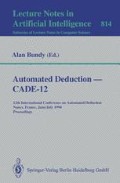Abstract
Most automated theorem provers suffer from the problem that they can produce proofs only in formalisms difficult to understand even for experienced mathematicians. Effort has been made to reconstruct natural deduction (ND) proofs from such machine generated proofs. Although the single steps in ND proofs are easy to understand, the entire proof is usually at a low level of abstraction, containing too many tedious steps. To obtain proofs similar to those found in mathematical textbooks, we propose a new formalism, called ND style proofs at the assertion level, where derivations are mostly justified by the application of a definition or a theorem. After characterizing the structure of compound ND proof segments allowing assertion level justification, we show that the same derivations can be achieved by domain-specific inference rules as well. Furthermore, these rules can be represented compactly in a tree structure. Finally, we describe a system called PROVERB, which substantially shortens ND proofs by abstracting them to the assertion level and then transforms them into natural language.
Preview
Unable to display preview. Download preview PDF.
References
P. B. Andrews. Transforming matings into natural deduction proofs. In Proc. of the 5th CADE, pages 281–292. Springer, 1980.
A. Bundy. The use of explicit plans to guide inductive proofs. In Proc. of 9th CADE, pages 111–120. Springer, 1988.
[CAB+86] R.L. Constable et al. Implementing Mathematics with the Nuprl Proof Development System. Prentice Hall, New Jersey, 1986.
D. Chester. The translation of formal proofs into English. AI, 7:178–216, 1976.
N. G. de Bruijn. A survey of the project AUTOMATH. In J. P. Seldin and J. R. Hindley, editors, To H.B. Curry — Essays on Combinatory Logic, Lambda Calculus and Formalism, pages 579–606. Academic Press, 1980.
P. Deussen. Halbgruppen und Automaten. Springer, 1971.
A. Edgar and F J. Pelletier. Natural language explanation of natural deduction proofs. In Proc. of the first Conference of the Pacific Association for Computational Linguistics. Simon Fraser University, 1993.
R. R. Fikes, P. E. Hart, and N. J. Nilsson. Learning and executing generalized robot plans. Artificial Intelligence, 3:251–288, 1972.
G. Gentzen. Untersuchungen über das logische schlie\en i. Math. Zeitschrift, 39:176–210, 1935.
M. Gordon, R. Milner, and C. Wadsworth. Edinburgh LCF: A Mechanized Logic of Computation. LNCS 78. Springer, 1979.
X. Huang et al. Ω-mkrp — a proof development environment. In these proceedings, 1994.
X. Huang. An extensible natural calculus for argument presentation. SEKI-Report SR-91-03, Universität Kaiserslautern, Germany, 1991.
X. Huang. Applications of assertions as elementary tactics in proof planning. In V. Sgurev and B. du Boulay, editors, Artificial Intelligence V — Methodology, Systems, Applications, pages 25–34. Elsevier, 1992.
X. Huang. An explanatory framework for human theorem proving. In H. J. Ohlbach, editor, GWAI-92: Advances in Artificial Intelligence, LNAI 671, pages 55–66. Springer, 1993.
X. Huang. Human Oriented Proof Presentation: A Reconstructive Approach. PhD thesis, Universität des Saarlandes, 1994, forthcoming.
P. N. Johnson-Laird. Mental Models. Harvard Univ. Press, 1983.
C. Lingenfelder. Transformation and Structuring of Computer Generated Proofs. PhD thesis, Universität Kaiserslautern, Germany, 1990.
D. D. McDonald. Natural language generation as a computational problem. In Brady/Berwick: Computational Models of Discourse. MIT Press, 1983.
D. A. Miller. Proofs in Higher-Order Logic. PhD thesis, CMU, Pittsburgh, 1983.
R. J. Mooney. Learning plan schemata from observation: Explanantionbased learning for plan recognition. Cognitive Science, 14:483–509, 1990.
A. Newell. Unified Theories in Cognition. Harvard University Press, 1990.
F. Pfenning. Proof Transformation in Higher-Order Logic. PhD thesis, CMU, Pittsburgh, 1987.
F. Pfenning and D. Nesmith. Presenting intuitive deductions via symmetric simplification. In Proc. of 10th CADE, pages 336–350. Springer, 1990.
E. H. Shortliffe. Computer-Based Medical Consultations: MYCIN. Elsevier, New York, 1976.
M. R. Wick and J. R. Slagle. An explanation facility for today's expert systems. IEEE Expert, 4(1):26–36, 1989.
M. R. Wick and W. B. Thompson. Reconstructive expert system explanation. Artificial Intelligence, 54:33–70, 1992.
Author information
Authors and Affiliations
Editor information
Rights and permissions
Copyright information
© 1994 Springer-Verlag Berlin Heidelberg
About this paper
Cite this paper
Huang, X. (1994). Reconstructing proofs at the assertion level. In: Bundy, A. (eds) Automated Deduction — CADE-12. CADE 1994. Lecture Notes in Computer Science, vol 814. Springer, Berlin, Heidelberg. https://doi.org/10.1007/3-540-58156-1_53
Download citation
DOI: https://doi.org/10.1007/3-540-58156-1_53
Published:
Publisher Name: Springer, Berlin, Heidelberg
Print ISBN: 978-3-540-58156-7
Online ISBN: 978-3-540-48467-7
eBook Packages: Springer Book Archive

